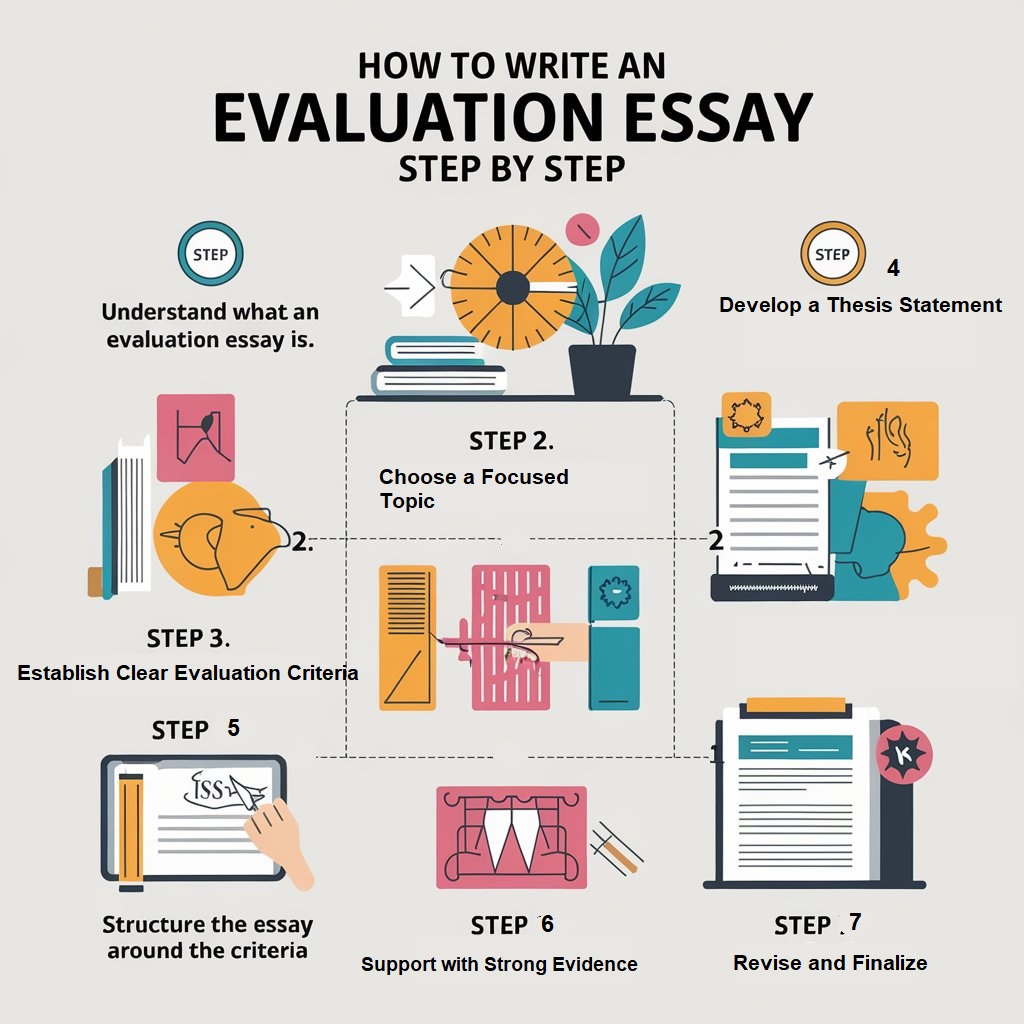Have you ever found yourself reading a movie review and thinking, “Wow, I agree with this!” or maybe “How did they come up with that?” Congratulations, you’ve just tasted what evaluation essays are all about!
An evaluation essay goes beyond simply saying something is “good” or “bad.” It’s your chance to dive deep, assess the value or quality of something, such as a book, a product, a service, a policy, or even a restaurant, and back up your opinion with solid evidence and transparent criteria. Consider blending a critic’s sharp eye with a scholar’s analytical mindset.
What Is An Evaluation Essay?
An evaluation essay is a type of academic writing in which the writer assesses and judges a specific topic, idea, or object. This essay aims to provide an opinion or judgment about the subject matter based on particular criteria and evidence.
Evaluation essay example
Evaluation essay topics
Technology
-
Assess the impact of AI code assistants on software development productivity.
-
Evaluate the effectiveness of AI vocal removers in music production.
-
Analyze the influence of digital product passports on consumer transparency.
Health & Wellness
-
Evaluate the rising popularity and potential health benefits of CBG gummies.
-
Assess the effectiveness of bamboo pajamas in promoting better sleep.
-
Analyze the trend of creatine gummies among fitness enthusiasts.
Fashion & Beauty
-
Evaluate the growing acceptance and market for men’s makeup products.
-
Analyze the resurgence of Rococo fashion in modern wardrobes.
-
Assess the influence of ‘Cherry Coded’ aesthetics on beauty trends.
Social Media & Culture
-
Evaluate the dominance of video content on social media platforms.
-
Analyze the importance of cultural fluency for brands in digital marketing.
-
Assess the effectiveness of brand storytelling in engaging online audiences.
Sports & Recreation
-
Evaluate the factors contributing to pickleball’s status as the fastest-growing sport.
-
Analyze the impact of esports on traditional sports viewership.
-
Assess the role of wearable technology in enhancing athletic performance.
Education
-
Evaluate the integration of AI tutors in personalized learning experiences.
-
Analyze the effectiveness of virtual reality classrooms in higher education.
-
Assess the impact of social media trends on student engagement and learning.
How to write an Evaluation Essay step by-step

Step 1: Understand What an Evaluation Essay Is
An evaluation essay judges a subject using a set of criteria. It’s not just about sharing personal opinions. It requires reasoned analysis backed by evidence.
Your goal is to answer the question:
“How good or effective is this subject, and based on what standards?”
You need to:
Step 2: Choose a Focused Topic
Pick a topic that can be evaluated using logical standards. It should be something that:
-
Is it specific enough to analyze thoroughly
-
Can be measured or judged
-
Holds interest or relevance for your audience
Examples of evaluation essay topics:
Avoid topics that are too broad or based only on personal taste without measurable aspects.
Step 3: Establish Clear Evaluation Criteria
Criteria are the standards you’ll use to assess your subject. They must be:
Example: Evaluating a food delivery app
Possible criteria:
-
Speed of delivery
-
Ease of use
-
Accuracy of orders
-
Cost and value
Use the same criteria throughout the essay to maintain consistency.
Step 4: Develop a Thesis Statement
Your thesis should:
Example: “Although the app offers a clean interface and fast delivery, its high fees and frequent technical issues make it a less-than-ideal option for budget-conscious users.”
This gives the reader a preview of your stance and how you’ll support it.
Step 5: Structure the Essay Around the Criteria
Organize your body paragraphs so that each one focuses on a specific criterion. This structure helps keep your evaluation clear and easy to follow.
Outline Example
Introduction
Body Paragraphs
(One paragraph per criterion, or more if needed)
-
Identify and explain the criterion
-
Evaluate how the subject meets or fails this standard
-
Offer evidence or examples (reviews, stats, expert opinions, or personal experience)
-
Explain how this affects your overall judgment
Optional Counterargument Paragraph
Conclusion
-
Restate your overall judgment
-
Summarize the key reasons for it
-
Reflect on the significance or offer a recommendation
Step 6: Support with Strong Evidence
To make your evaluation persuasive:
-
Use facts and statistics when applicable
-
Include expert opinions or credible reviews
-
Reference personal experiences if relevant and appropriate
-
Compare your subject to similar alternatives
Avoid making claims that can’t be supported. The stronger your evidence, the more credible your evaluation will be.
Step 7: Revise and Finalize
During revision:
-
Check that each criterion is applied consistently
-
Ensure each body paragraph supports the thesis
-
Watch for biased or overly emotional language
-
Smooth out transitions for better flow
-
Proofread for grammar, clarity, and coherence
Practical Example of Evaluation Essay with Analysis
Essay: Evaluating the Effectiveness of AI Writing Tools in 2025
In the digital age 2025, AI writing tools have become increasingly popular among students, professionals, and content creators. Tools like ChatGPT, Grammarly, and Jasper promise to enhance productivity, improve writing quality, and assist users in generating creative content efficiently. While these tools offer undeniable convenience and accessibility, their effectiveness depends on accuracy, user-friendliness, and ethical considerations. Upon evaluation, it becomes clear that although AI writing tools are helpful for quick drafting and basic edits, they still fail to produce nuanced, original writing without human oversight.
To fairly assess the effectiveness of AI writing tools, three main criteria must be considered: accuracy of content, ease of use, and ethical reliability. These standards are critical because users rely on these tools for grammar corrections, idea generation, and content development. If an AI tool fails to meet these criteria, its usefulness diminishes significantly.
First, AI writing tools have made impressive strides in accuracy. They can now correct complex grammar mistakes, suggest advanced vocabulary, and even mimic certain writing styles. For example, Grammarly’s AI-powered suggestions in 2025 go beyond basic grammar to include tone adjustment and clarity enhancements. However, while AI tools handle surface-level writing well, they occasionally produce factual inaccuracies or overly generic statements. When writing about niche or technical subjects, AI tools may generate outdated or incorrect information, requiring human verification. This limits their reliability, especially in academic or professional contexts where precision is critical.
Second, ease of use is a major advantage of AI writing tools. Most of these tools are accessible through web platforms or browser extensions, allowing users to integrate them seamlessly into their writing process. ChatGPT, for instance, provides a user-friendly interface that makes it simple to generate drafts or brainstorm ideas. The intuitive design and real-time suggestions reduce the learning curve for new users. However, ease of use can sometimes lead to over-reliance, where users accept AI-generated content without critical review. While the interface is helpful, it should not replace the writer’s own engagement with the material.
Lastly, ethical reliability remains a significant concern. AI writing tools draw from vast amounts of data, which raises questions about originality and plagiarism. Many tools now include plagiarism checkers, but they still rely on pre-existing data patterns. This can result in content that unintentionally mirrors other works. Furthermore, there are concerns about privacy, as users may unknowingly share sensitive information while using these platforms. Without clear regulations and transparency from AI developers, users may risk compromising their intellectual property.
In conclusion, AI writing tools in 2025 present a valuable resource for improving writing efficiency and accessibility. They excel in providing quick corrections and aiding in idea generation. However, their occasional inaccuracies, potential for user over-reliance, and unresolved ethical concerns mean they should be used as assistants rather than replacements for human writers. For best results, users should view AI writing tools as helpful companions that support, but do not substitute, their critical thinking and creativity.
Analysis of the Essay
| Section |
What the Essay Did |
| Introduction |
– Hook: Mentions the rise of AI writing tools in 2025.
– Background: Lists popular tools and their promises.
– Thesis: States an overall judgment (“helpful for quick drafting but fall short for nuanced writing”). |
| Criteria for Evaluation |
– Identifies three criteria: accuracy, ease of use, and ethical reliability.
– Explains why these criteria matter for the evaluation. |
| Body Paragraph 1: Criterion 1 (Accuracy) |
– States the criterion (accuracy).
– Gives examples (Grammarly’s advanced suggestions).
– Analyzes strengths and weaknesses (good for grammar, less reliable for niche content).
– Links back to the overall evaluation. |
| Body Paragraph 2: Criterion 2 (Ease of Use) |
– States the criterion (ease of use).
– Provides example (ChatGPT’s interface).
– Discusses positives (accessible, seamless) and cautionary negatives (over-reliance). |
| Body Paragraph 3: Criterion 3 (Ethical Reliability) |
– States the criterion (ethics).
– Explains issues like plagiarism risks and data privacy.
– Provides thoughtful analysis of potential problems. |
| Conclusion |
– Restates overall evaluation.
– Summarizes key findings from the criteria.
– Ends with a recommendation: use AI tools as assistants, not replacements. |
| Tone & Focus |
– Maintains evaluative tone throughout.
– Balanced perspective: acknowledges both positives and limitations.
– Uses specific, relevant examples. |
Evaluation Essay Outline
Introduction
-
Hook: Engage your reader with an interesting fact, question, or brief story about your subject.
-
Context/Background: Briefly introduce the subject you will evaluate (product, service, trend, event, etc.).
-
Purpose of Evaluation: Explain why you are evaluating this subject.
-
Thesis Statement (Overall Judgment): Clearly state your overall evaluation/judgment based on specific criteria.
Criteria for Evaluation
Body Paragraphs: Criterion-Based Evaluation
Paragraph 1: Criterion 1
-
Topic sentence: Introduce your first criterion.
-
Analysis: Evaluate how the subject meets or fails this criterion.
-
Evidence: Provide specific examples, facts, statistics, or expert opinions.
-
Mini-judgment: Summarize your evaluation for this point.
Paragraph 2: Criterion 2
Paragraph 3: Criterion 3
Counterargument or Limitations (Optional but Strong Addition)
Conclusion
-
Restate Thesis: Paraphrase your overall judgment.
-
Summarize Key Evaluations: Recap your criteria and findings.
-
Closing Insight: End with a final thought — recommendation, broader implication, or reflection.
FAQ
1. What is an evaluation essay?
An evaluation essay is a type of academic writing that assesses a subject’s quality, effectiveness, or value using specific criteria. It involves making a reasoned judgment supported by evidence and examples.
2. How is an evaluation essay different from a review?
While both involve judgment, an evaluation essay is more structured and academic. It uses defined criteria, logical reasoning, and evidence, whereas a review can be more informal and based on personal opinion.
3. What are good topics for an evaluation essay?
Good topics are specific, evaluatable, and relevant. Examples include:
4. What are the evaluation criteria?
Criteria are the standards or benchmarks you use to judge your subject. They should be relevant, fair, and consistent throughout your essay. For example, criteria might include food quality, service, pricing, and atmosphere when evaluating a restaurant.
5. How do I write a strong thesis for an evaluation essay?
A strong thesis clearly states your overall judgment, names the subject, and hints at the criteria used. Example:
“Despite its creative concept and user-friendly design, the app lacks reliable performance and customer support, making it less practical for daily use.”
6. Can I use personal experience as evidence?
Yes, personal experience can be practical if it’s relevant and balanced with other types of evidence like statistics, expert opinions, or comparisons. Just avoid relying only on personal views.
7. Do I need to include a counterargument?
It’s not always required, but including a counterargument can make your essay more balanced. Briefly acknowledging other perspectives shows fairness and strengthens your overall position.
8. How many criteria should I include?
Typically, include at least three substantial criteria. More can be added if necessary, but each one should be developed with enough depth and evidence in its paragraph.
9. How do I organize the body of an evaluation essay?
Each body paragraph should focus on one criterion:
10. What tone should I use?
Keep a formal, objective, and respectful tone—even when your judgment is critical. Avoid sarcasm, emotional language, or overly biased phrasing.









 Evan John
Evan John